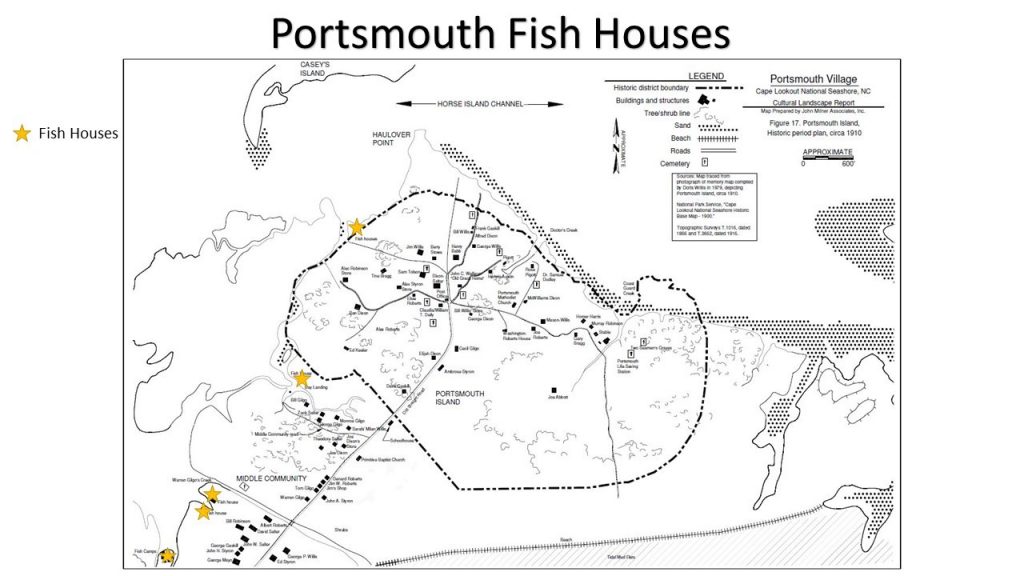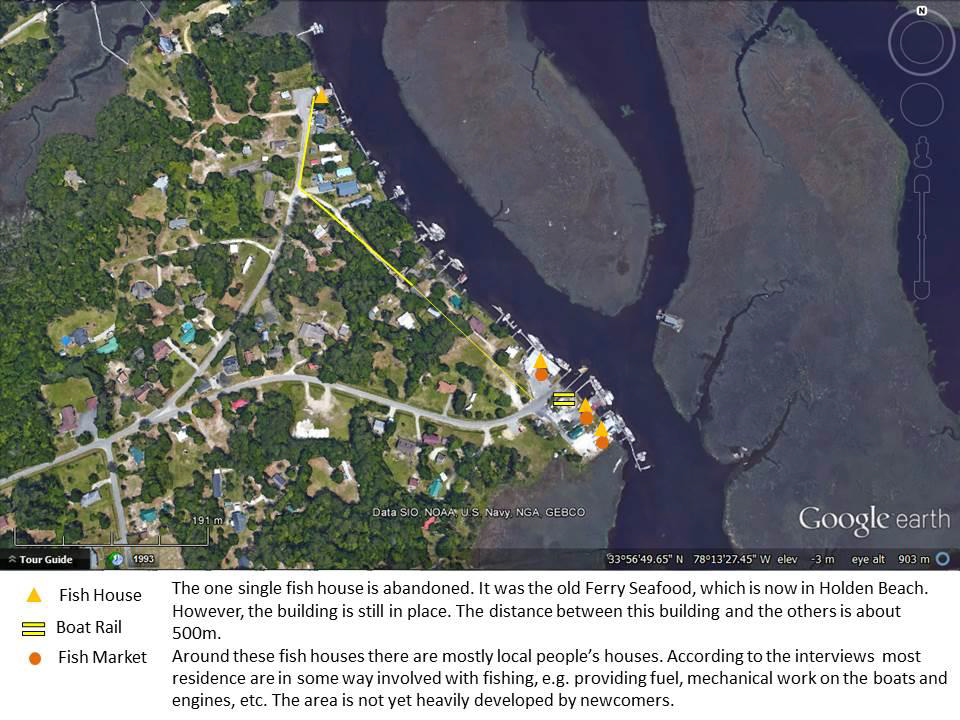PORTSMOUTH ISLAND

SHALLOTTE (Courtesy of Sorna Khakzad)
 Shallotte is the furthest south commercial fishing community in Brunswick County before Calabash. This area also is the closest of the four communities to the Gordon Net Shop. Although there are several other locations such as S&S Marine that sell nets and provide services for net repair, Gordon net Shop is the only shop in the area whose only activity is net making and repair . The two fish houses in Shallotte are very different in their way of operating and success. The northern one (Holden Seafood and its adjacent seafood market) is to some extent isolated. The area is dominated by new urban development. According to the fishermen, big boats cannot get there anymore, due to the fact that the channel is not being dredged and is not deep enough anymore, and therefore the business have gone down. However, two kilometers down along the same channel, the Lloyd’s Oyster House is operating well [Img. 02]. The houses around this oyster house are mostly local residents and fewer outsiders live in the surrounded area. Still large untouched natural landscape exists close to this fish house. In addition, the fish house is near a local seafood restaurant and a boat yard. In fact, the fish for the restaurant is partly provided by Lloyd’s. The concentrations of the activities of the oyster house, boat yard and the restaurant, in addition to more local people living in this area and involved in fishing related activities, have provided a stronger sense of place and maritime landscape in this area than in the area around Holden’s Seafood. Lloyd’s Oyster House has a good networking between the suppliers (fishermen) and the buyers. The good contact between fishermen and the oyster house, and the distribution of the fish/oyster to the local restaurants, as well as its vicinity to other fishing related activities are the strong points of Lloyd’s Oyster House. On the contrary, although Holden Seafood has a market as a point of connection with public, its location and lack of networking among fishermen, and difficulties of navigation of big boats in the river, along with growing urban development, have caused its isolation, and reduced its strong sense of place regarding the physical aspects of maritime cultural landscape.
Shallotte is the furthest south commercial fishing community in Brunswick County before Calabash. This area also is the closest of the four communities to the Gordon Net Shop. Although there are several other locations such as S&S Marine that sell nets and provide services for net repair, Gordon net Shop is the only shop in the area whose only activity is net making and repair . The two fish houses in Shallotte are very different in their way of operating and success. The northern one (Holden Seafood and its adjacent seafood market) is to some extent isolated. The area is dominated by new urban development. According to the fishermen, big boats cannot get there anymore, due to the fact that the channel is not being dredged and is not deep enough anymore, and therefore the business have gone down. However, two kilometers down along the same channel, the Lloyd’s Oyster House is operating well [Img. 02]. The houses around this oyster house are mostly local residents and fewer outsiders live in the surrounded area. Still large untouched natural landscape exists close to this fish house. In addition, the fish house is near a local seafood restaurant and a boat yard. In fact, the fish for the restaurant is partly provided by Lloyd’s. The concentrations of the activities of the oyster house, boat yard and the restaurant, in addition to more local people living in this area and involved in fishing related activities, have provided a stronger sense of place and maritime landscape in this area than in the area around Holden’s Seafood. Lloyd’s Oyster House has a good networking between the suppliers (fishermen) and the buyers. The good contact between fishermen and the oyster house, and the distribution of the fish/oyster to the local restaurants, as well as its vicinity to other fishing related activities are the strong points of Lloyd’s Oyster House. On the contrary, although Holden Seafood has a market as a point of connection with public, its location and lack of networking among fishermen, and difficulties of navigation of big boats in the river, along with growing urban development, have caused its isolation, and reduced its strong sense of place regarding the physical aspects of maritime cultural landscape.
VERNAM TOWN(Courtesy of Sorna Khakzad)
 Varnamtown has three fish houses still operating, with fish markets adjacent to them, in addition to a boat rail (the only boat rail in southeastern North Carolina). Furthermore, there is one fish house that has closed, but the building and its dock are still in place. The area around Varnamtown fishing community has not yet been gentrified with new development. Most residents are local people, engaged in fishing related businesses, if not fishing then other services, such as boat repair, providing fuel for fishing boats, packing seafood, and making nets and TEDs for shrimpers. The area is in closer to the inlet and to the ocean, and therefore, more and bigger fishing boats can reach these fish houses. These fish houses are very close to each other and have a good connection with each other [Img. 01]. Additionally, they enjoy a well-managed distribution of seafood, including imported and locally caught shrimp, not only through wholesale, but also through direct contact with individual customers. Fishermen and fish house owners have a common social-cultural memory from the past and value their fishing tradition.
Varnamtown has three fish houses still operating, with fish markets adjacent to them, in addition to a boat rail (the only boat rail in southeastern North Carolina). Furthermore, there is one fish house that has closed, but the building and its dock are still in place. The area around Varnamtown fishing community has not yet been gentrified with new development. Most residents are local people, engaged in fishing related businesses, if not fishing then other services, such as boat repair, providing fuel for fishing boats, packing seafood, and making nets and TEDs for shrimpers. The area is in closer to the inlet and to the ocean, and therefore, more and bigger fishing boats can reach these fish houses. These fish houses are very close to each other and have a good connection with each other [Img. 01]. Additionally, they enjoy a well-managed distribution of seafood, including imported and locally caught shrimp, not only through wholesale, but also through direct contact with individual customers. Fishermen and fish house owners have a common social-cultural memory from the past and value their fishing tradition.
HOLDEN BEACH (Courtesy of Sorna Khakzad)
 Fish markets, fish houses and docks can be seen in several locations along the shoreline of Intercostal Waterway in the Holden Beach area which provides a sense of active commercial fishing. Several shrimp boats were observed during the field work. There are three fish houses in Holden Beach and located about a kilometer from each other along the northern shoreline of the Intracoastal Waterway. They have a strong connection with the public through the fish markets adjacent to them. The owners remember the past fondly. There are a couple of boat yards and docks close by and a famous fish market on the other side of the waterway. They have established a good connection to public through sharing historic pictures, selling shells from the fishing trips, and sharing stories. Fishermen have a good network and most of them are connected to each other. The area around these fish houses are mostly wetlands and marshes. Therefore, less urban development can be seen.
Fish markets, fish houses and docks can be seen in several locations along the shoreline of Intercostal Waterway in the Holden Beach area which provides a sense of active commercial fishing. Several shrimp boats were observed during the field work. There are three fish houses in Holden Beach and located about a kilometer from each other along the northern shoreline of the Intracoastal Waterway. They have a strong connection with the public through the fish markets adjacent to them. The owners remember the past fondly. There are a couple of boat yards and docks close by and a famous fish market on the other side of the waterway. They have established a good connection to public through sharing historic pictures, selling shells from the fishing trips, and sharing stories. Fishermen have a good network and most of them are connected to each other. The area around these fish houses are mostly wetlands and marshes. Therefore, less urban development can be seen.